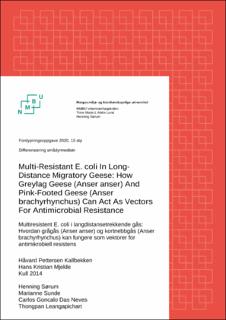| dc.contributor.advisor | Sunde, Marianne | |
| dc.contributor.advisor | Sørum, Henning | |
| dc.contributor.advisor | Goncalo Das Neves, Carlos | |
| dc.contributor.author | Kallbekken, Håvard Pettersen | |
| dc.contributor.author | Mjelde, Hans Kristian | |
| dc.date.accessioned | 2020-06-04T11:34:45Z | |
| dc.date.available | 2020-06-04T11:34:45Z | |
| dc.date.issued | 2020 | |
| dc.identifier.uri | https://hdl.handle.net/11250/2656553 | |
| dc.description.abstract | Migratory birds can carry antimicrobial resistant E. coli over large distances. Recent studies show antimicrobial resistance in bacteria from wildlife, carrying resistance genes against drugs listed on the “WHO’s List of Essential Medicines”. During autumn 2015 and 2019, a total of 201 cloaca samples were collected from Greylag and Pink-footed geese landing close to farm areas in the middle of Norway during their flight towards their wintering grounds. A total of forty-three samples screened in 2015 (39%) contained E. coli expressing a resistance to one or more drugs, whereas 26 of the samples from 2019 (29%) contained resistant strains with close to equally the same resistance patterns. We found isolates resistant to quinolones, tetracyclines and other types of antibiotics. Several isolates had multi-resistant patterns. Isolates resistant against colistin belonged to ST720, which is identified as a possible pathogenic sequence type through phylogenetic identification (phylotype D). Around one third of the birds sampled contained E. coli resistant against one or more antimicrobial agents, indicating that migrating birds can act as vectors for resistant bacteria. | en_US |
| dc.language.iso | eng | en_US |
| dc.publisher | Norwegian University of Life Sciences, Ås | en_US |
| dc.rights | Attribution-NonCommercial-NoDerivatives 4.0 Internasjonal | * |
| dc.rights.uri | http://creativecommons.org/licenses/by-nc-nd/4.0/deed.no | * |
| dc.title | Multi-Resistant E. coli In Long-Distance Migratory Geese: How Greylag Geese (Anser anser) And Pink-Footed Geese (Anser brachyrhynchus) Can Act As Vectors For Antimicrobial Resistance | en_US |
| dc.title.alternative | Multiresistent E. coli i langdistansetrekkende gås: Hvordan grågås (Anser anser) og kortnebbgås (Anser brachyrhynchus) kan fungere som vektorer for antimikrobiell resistens | en_US |
| dc.type | Student paper, others | en_US |
| dc.source.pagenumber | 75 | en_US |

